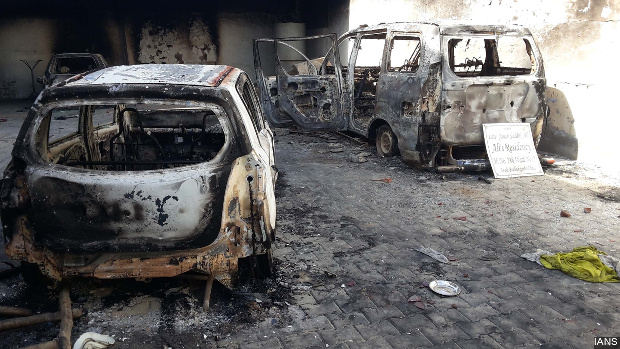Religious Riots Down In 2015, But Other Riots Rise
Burnt vehicles in Ballabhgarh town of Haryana, May 2015. The rich agricultural state of Haryana saw most of India's communal rioting cases (201 out of 789) in 2015, though the overall incidence of communal riots in the country came down by 33% over the previous year 2014.
Religious tension in Ballabhgarh, Haryana, when 150 Muslims sought refuge in a police station; clashes between Hindus and Muslims during Ganesh festival processions in Belgaum, Karnataka, and riots over the birth anniversary celebrations of medieval ruler Tipu Sultan in Madikeri, Karnataka, represented India's religious volatility in 2015.
However, communal rioting cases in the country declined by a third, from 1,227 in 2014—the year that Narendra Modi was voted Prime Minister—to 789 in 2015, according to National Crime Records Bureau (NCRB) data.
About 40% fewer Indians died or were injured—called "victims" in NCRB terminology—in 2015 (1,1,74) than in 2014 (2,001).
Haryana, India's 17th largest state by population, reported the most (201) communal rioting cases in 2015, with 200 dead or injured, followed by Karnataka (163 cases, 203 victims), Maharashtra (80 cases, 104 victims) and Bihar (79 cases, 146 victims).
In Haryana, the rate of riots remained unchanged at 7.5 rioting cases per million population. Karnataka reported an increase in riot incidence, from 0.6 rioting cases per million to 2.6 rioting cases per million, while the cases quadrupled, from 38 in 2014 to 163 in 2015.
Kerala had more "political riots" than any other state, with more than half of India's cases.
Jharkhand reduced its rate of riots, from 10 rioting cases per million to 2 per million. The overwhelmingly tribal state became five times more communally peaceful in 2015 compared to 2014--when assembly elections were conducted--with communal rioting cases dropping 80% from 349 to 68.
After relatively peaceful decade, riots on the rise across India
Thirty-five years after rioting cases in India peaked at 160 per million in 1980, the country witnessed a relatively peaceful decade with respect to communal violence, especially in the period 2003-2012, when riot rate dropped to 50 cases per million.
The incidence of riots has increased over the last three years to 60 cases per million, or 20% more frequent compared to the last decade.
Source: National Crime Records Bureau
Rioting cases increased 251% over six decades, from 20,529 in 1953 to 76,131 in 2015; the highest ever. For 2014 and 2015, we have included in "riots" crimes listed under "unlawful assembly" because they were clubbed together in previous years.
Source: Crime In India Reports, 1997 to 2015, National Crime Records Bureau
Note: For 2014 and 2015, we have included in "riots" crimes listed under "unlawful assembly" because they were clubbed together in previous years.
Of 76,131 rioting cases registered in 2015, 65,255 were filed under sections 147 to 153 of the Indian Penal Code (IPC), meaning offences relating to riots, while 10,876 cases were filed under sections 141 and 142 of the IPC, meaning offences relating to unlawful assembly. As many as 74,633 cases in 2012 and 72,126 in 2013 were registered under riots and unlawful assembly.
Cases filed only under "riots" have decreased between 2014 and 2015, while those relating to "unlawful assembly" have increased.
Source: Crime in India 2015, National Crime Records Bureau
Note: For 2014 and 2015, we have included in "riots" crimes listed under "unlawful assembly" because they were clubbed together in previous years.
Mass unrest nationwide in 2015 by dominant caste groups—Patels in Gujarat and Jats in Haryana—likely resulted in the high cases of "unlawful assembly".
Bihar and Kerala: Riot leaders of India
In absolute terms, Bihar had more riots than any other state with 13,311 cases registered in 2015, followed by Maharashtra (8,336), Uttar Pradesh (6,813), Karnataka (6,602).
The assembly elections in Bihar in 2015, and the parting of ways of the 25-year old coalition of the Janata Dal (United) (JDU) and Bharatiya Janata Party (BJP) resulted in a rise in riots in the Hindi heartland state over three years from 2013, the Indian Express reported in August 2015.
Kerala had 164 rioting cases per million population—the country’s highest rate—followed by Bihar (129), Karnataka (126).
While Jharkhand reported eight caste-based rioting cases per million population, Tamil Nadu reported six.
Bihar reported more "agrarian riots" cases than any other state, (1,156), or 43% of cases in the country.
(Waghmare is an analyst with IndiaSpend.)
We welcome feedback. Please write to respond@indiaspend.org. We reserve the right to edit responses for language and grammar.
__________________________________________________________________
“Liked this story? Indiaspend.org is a non-profit, and we depend on readers like you to drive our public-interest journalism efforts. Donate Rs 500; Rs 1,000, Rs 2,000.”



